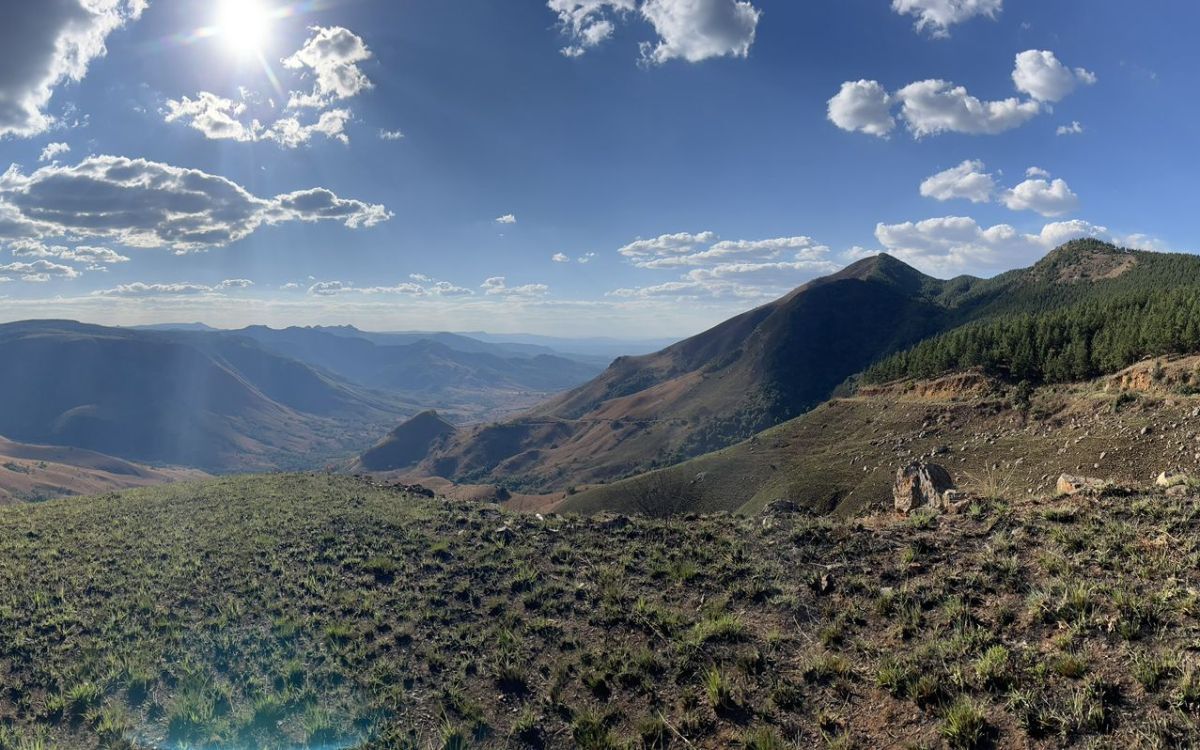Finding ingenious design in nature
Joanna Aizenberg combs the beach for engineering marvels
“This,” Joanna Aizenberg says slyly, picking up a latticed tube from her desk in Pierce Hall, “is a glass house you can throw stones at.”
The tube, tapered to a close at one end and festooned with a cluster of curious white fibers at the tip, resembles an upturned dog’s tail. It is, in fact, the skeleton of a deep-sea sponge, she reveals, made entirely out of a natural glass. The tube acts as a kind of high-rise apartment building for shrimp that live symbiotically in the sponge’s tissue.
The glass, drawn thinly into lacy threads, looks astonishingly fragile for a structure that withstands thousands of pounds of pressure per square inch at depths exceeding 500 meters below the ocean surface.
Aizenberg agrees. “It’s incredibly strong — but why? What mechanical principles make this particular design work so well?”
As the Gordon McKay Professor of Materials Science in Harvard’s School of Engineering and Applied Sciences, one of Aizenberg’s current projects is to use synthetic materials to model and modify the sea-sponge structure. Tinkering with the glass lattice design allows her to see exactly what each geometric element — whether it is the tube’s foundational mesh of squares with diagonals, or its helical external ridges — contributes to the strength and flexibility of the whole.
“Nature builds structures, and it builds them better than we do. There are new design principles to be taken from nature. My job,” says Aizenberg, the Susan S. and Kenneth L. Wallach Professor at the Radcliffe Institute for Advanced Study, “is to find out what they are and how to use them.”
Finding natural structures to study is the first order of business, and much of the initial stage of Aizenberg’s research sounds like a good ocean-side summer holiday in disguise: rummaging in bins and dark corners of curiosity shops, beachcombing, and even snorkeling.
As a Ph.D. student in Israel, Aizenberg went on regular diving expeditions in the Red Sea, collecting whatever she could from the sea floor. When she’s at the beach, she keeps an eye out for shells with unusual changes in their design.
Her analytical instinct in this regard is as restless as her search. “I try to think of what’s responsible for the change,” she says, “whether it’s a protein or the local salinity, or even a mechanical principle that might result in some interesting aberration.”
Sometimes the search for specimens can be as revealing as the analysis itself. When Aizenberg found the sea sponge in a curiosity shop, it had been lying in a dark corner on the lowest shelf.
“It was unusually bright — surprisingly bright, which gave me the idea that these hairs on the end are optical fibers that light up the whole structure,” she says. “We think we just now invented fiber optics for telecommunications, but this sponge has benefited from it for millennia.”
The sponge, she speculates, uses the fibers for its own communication purposes: The fibers direct light from bioluminescent bacteria into the glass structure. Small deep-sea organisms flock to the glowing glass — a useful perk in a low-food-density zone for preying shrimp.
Aizenberg’s hypothesis about the function of the fibers — a deep-sea version of room service for shrimp — makes the structure sound less like a high-rise than a high-class hotel. An offhand remark underscores this impression of elegance and polish: “This sponge is considered to be a work of art by glass designers. Almost anything that nature makes has the artistic touch. People didn’t even realize that it’s a biological form.”
Aizenberg takes the philosophical underpinnings of her research to heart. Her projects knock down disciplinary walls, cross-cutting old categorical divisions between nature and artifice. Her research fairly shouts that what is natural is built, and what is built is built best from nature’s blueprints.
The architectural metaphors are not lost on her. Her work aligns itself closely with the design-oriented disciplines that cluster around material science and mechanical engineering. In the course of her career she has, in fact, cultivated a fierce allegiance to the arts.
She guest-lectures for classes at New York School of Design and has given talks at the Science and Art Cabaret in Greenwich Village. At the moment she is hatching a plan for an undergraduate course on nature and design. She holds a joint appointment with the Radcliffe Institute for Advanced Study, a position that brings her into contact with each year’s fresh crop of Radcliffe Fellows, selected from an enormous range of fields in the humanities, social sciences, and natural sciences.
She admits that, after working for years in industry at Bell Laboratories, the Radcliffe appointment was one of her reasons for choosing to teach at Harvard.
“The community is unbelievable,” she says. “It’s unmatched. Nowhere in the world do you have the kind of collaboration you find here — the bringing together of engineering, chemistry, medicine, developing fields — science and art. People think that science and art don’t have anything to do with each other.”
Aizenberg jumps from her desk and hurries over to a bulletin board adorned with Science magazine covers showing magnified crystal formations.
“But take biologically formed crystals. I did my undergraduate and graduate degree in crystallography and found myself often spending time in the microscope room simply admiring their incredible formations. They’re art. I sometimes forget that I’m doing science because it’s just so beautiful.”
Before returning to her desk, she makes a detour toward a collection of brightly colored plastic toys amassed on her windowsill. Like a grade-schooler at show-and-tell, she proffers a set of Rubik’s Cubes in dimensions of 2 inches, 3 inches, 4 inches, and Homer Simpson.
Homer’s bust, cut into eight swiveling quadrants (a contoured version of the 2-inch cube), is actually quite a hard puzzle, Aizenberg says. “You’re looking at only the facial features to solve it, and it’s confusing.”
Aizenberg, it turns out, collects puzzles and toys in addition to her natural curiosities. Her wonder and gleeful delight at both are the same: When she tosses up a segmented shell of interlinking blue plastic joints, the toy expands midair and flips inside out before landing back in her palm in a flaming shade of pink.
“Did you see it change color?” she asks excitedly. “Did you see it change color?”





